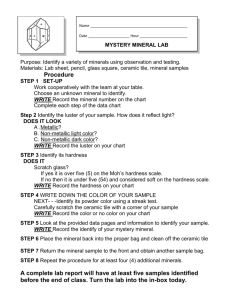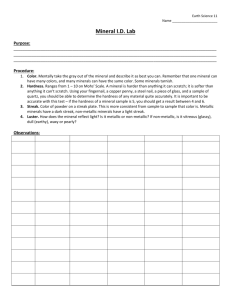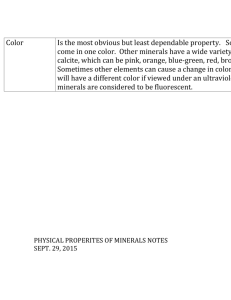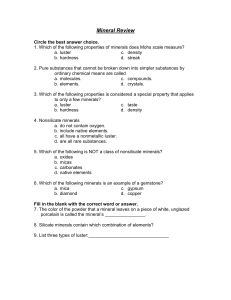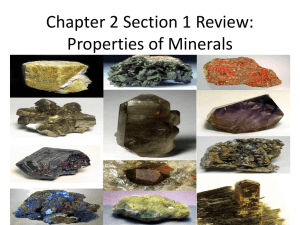printer-friendly sample test questions
advertisement
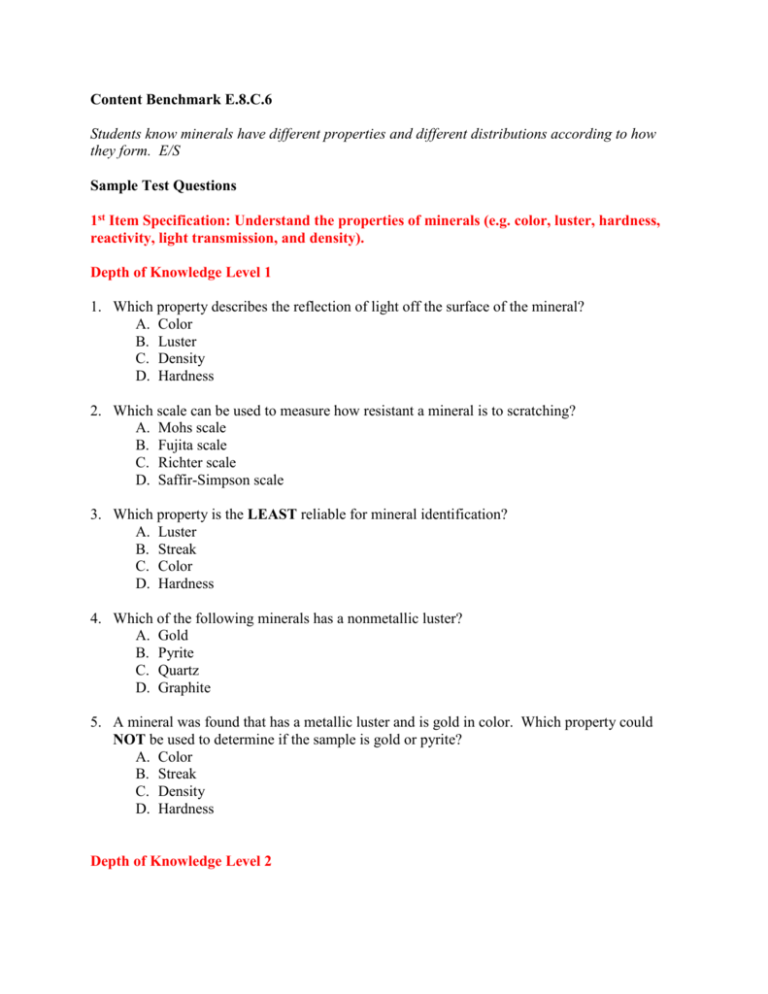
Content Benchmark E.8.C.6 Students know minerals have different properties and different distributions according to how they form. E/S Sample Test Questions 1st Item Specification: Understand the properties of minerals (e.g. color, luster, hardness, reactivity, light transmission, and density). Depth of Knowledge Level 1 1. Which property describes the reflection of light off the surface of the mineral? A. Color B. Luster C. Density D. Hardness 2. Which scale can be used to measure how resistant a mineral is to scratching? A. Mohs scale B. Fujita scale C. Richter scale D. Saffir-Simpson scale 3. Which property is the LEAST reliable for mineral identification? A. Luster B. Streak C. Color D. Hardness 4. Which of the following minerals has a nonmetallic luster? A. Gold B. Pyrite C. Quartz D. Graphite 5. A mineral was found that has a metallic luster and is gold in color. Which property could NOT be used to determine if the sample is gold or pyrite? A. Color B. Streak C. Density D. Hardness Depth of Knowledge Level 2 6. Use Mohs Scale of Hardness to answer the question. (From http://geology.csupomona.edu/alert/mineral/mohs.gif) Which mineral would be weathered the MOST after being placed in a rock tumbler for fifteen minutes? A. Gypsum B. Fluorite C. Topaz D. Diamond 7. Use the chart to answer the following question. (From http://users.freshpond.net/a/ayerahs/3761/351/Minerals.pdf) Which mineral has a different color in its powdered form than its original form? A. Graphite B. Kaolinite C. Magnetite D. Pyrite 2nd Item Specification: Understand how minerals form and where they are typically found. Depth of Knowledge Level 1 8. The most likely way for a crystal to form is by A. boiling. B. evaporation. C. condensation. D. sublimation. 9. Minerals are found A. as liquids. B. in all rock types. C. only as native elements. D. as renewable natural resources. 10. In the desert, water evaporates and leaves deposits of salt crystals. These crystals are known as A. talc and calcite. B. quartz and topaz. C. gypsum and halite. D. fluorite and apatite. 11. The range of chemical composition in a mineral typically results from A. time and place of origin. B. change in atomic structure. C. changes in physical properties. D. inclusions of other mineral grains. Depth of Knowledge Level 2 12. Hematite is a mineral that forms during the weathering of iron-bearing minerals. It is essentially rusted; therefore, what must be present in order for hematite to form? A. Magma B. Salt C. Lava D. Water 13. Use the diagram to answer the following question. (From http://rmfs1.ortn.edu/myschool/rking/web/mineralsg.htm) Which diagram shows the formation of minerals with the relatively largest crystal size? A. Diagram C as there is almost the same amount of lava and magma in the diagram. B. Diagram B because magma takes a longer amount of time to cool than lava. C. Diagram B as magma has a shorter cooling time than lava. D. Diagram A because the mineral solution is above the magma. Constructed Response E.8.C.6 1. The data table below shows the color, luster, and streak of five unidentified mineral samples. A. Which mineral samples have different color in its powdered from than its original form? B. Explain how you could determine the relative hardness of each mineral sample. C. What tools would a field geologist need to take on a job that would require fluorite, calcite, quartz, and gypsum to be distinguished? Explain why is each of these tools is necessary and important. Content Benchmark E.8.C.6 Students know minerals have different properties and different distributions according to how they form. E/S Answers to Sample Test Questions 1. B, DOK Level 1 2. A, DOK Level 1 3. C, DOK Level 1 4. C, DOK Level 1 5. A, DOK Level 1 6. A, DOK Level 2 7. D, DOK Level 2 8. B, DOK Level 1 9. B, DOK Level 1 10. C, DOK Level 1 11. A, DOK Level 1 12. D, DOK Level 2 13. B, DOK Level 2 Constructed Response 3 Point Answer and Score Rubric: Response addresses all parts of the question clearly and correctly. Mineral sample A, C, or D has a different color than its streak. 3 points Much in the same way that Mohs hardness scale was developed, two unknown samples could be rubbed against each other to see which sample scratches the other. The harder sample will scratch the softer sample. For instance, if Sample B scratches Sample A, then you know that Sample A is softer than Sample B. If Sample C and Sample A are rubbed together and Sample C scratches Sample A, then you know that Samples B and Sample C are harder than Sample A. Continue the process comparing two samples at a time to create an ordered relative hardness for the samples. A geologist would have to bring a piece of unglazed porcelain to use as a streak plate, a kit to test hardness including a glass plate and a steel blade, a rock hammer to check the fracture and cleavage and safety goggles. These tools are important because all samples could be found to have the same color, so the samples could not be identified solely by color. The samples have differing hardness, cleavage/fracture and streak (all have the same color streak, however if the fluorite or calcite samples are found in a different color, the streak will confirm the identification). Once the other properties are determined, then identification could be confirmed. 2 points Response addresses all parts of the question and includes only minor errors. 1 point Response does not address all parts of the question. 0 points Response is totally incorrect or no response was provided.

